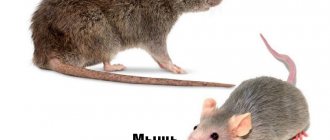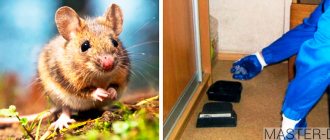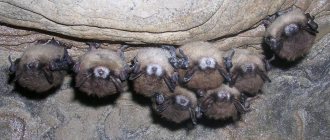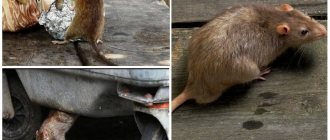How are pathogens transmitted?
Even if a person has never been bitten by a mouse, this does not mean that he is out of the risk zone. The variety of ways in which disease can be transmitted from mice is truly amazing.
You can become infected in the following ways:
- consume food or water contaminated with feces of a sick animal;
- inhale dust containing fur and droppings;
- in direct contact with a decomposing rodent corpse;
- immediately after the bite.
You can even get infected from your pet.
Some viruses are carried by ticks and fleas that feed on the blood of an infected mouse. Also, a cat that has eaten an infected rodent can itself become a carrier of the disease.
Hemorrhagic fever with renal syndrome (HFRS)
Hemorrhagic fever with renal syndrome (HFRS) is a group of clinically similar diseases caused by hantaviruses of the family Bunyaviridae.
Symptoms of Hemorrhagic Fever with Renal Syndrome (HFRS) usually develop within 1–2 weeks after exposure to infected materials, but in rare cases can take up to 8 weeks to develop. Initial symptoms appear suddenly and include severe headaches, back and abdominal pain, fever, chills, nausea and blurred vision. People may have facial flushing, sore or red eyes, or a rash. Late symptoms may include low blood pressure, acute shock, and acute renal failure, which can cause severe fluid overload. The severity of the disease varies depending on the virus causing the infection. Hantaan and Dobrava virus infections usually cause severe symptoms, while Seoul, Saaremaa and Puumala virus infections are more mild. Full recovery from rat disease may take weeks or months.
Hemorrhagic fever with renal syndrome occurs throughout the world. Haantan virus is widespread in East Asia, especially in China, Russia and Korea. Puumala virus is found in Scandinavia, Western Europe and Western Russia. The Dobrava virus is found mainly in the Balkans, while the Seoul virus is found throughout the world. The Saaremaa virus is found in Central Europe and Scandinavia. In America, hantaviruses cause another disease known as hantavirus pulmonary syndrome.
7 main diseases that can be contracted from mice
Just a century ago, the most common diseases carried by rodents included typhoid and plague. But at the moment, only isolated cases of death from infection with such infections are recorded. Therefore, doctors' attention is drawn to the following diseases.
Salmonellosis
One of the most common diseases carried by rodents is salmonellosis. Infection occurs through contact with mouse feces. The danger with salmonellosis is that an infected person can also pass the bacteria on to anyone else. One of the strains of salmonella (Enterica) provokes the development of typhoid fever. The disease must be promptly treated with antibiotics and vaccination because, otherwise, infectious-toxic shock may develop.
Salmonella
Leptospirosis
This infectious disease is caused by bacteria of the Leptospira species, which are found in the urine of infected rodents. Most often, Leptospira enters the human body (through the mouth, damaged mucous membranes of the eyes and nose) after direct contact with mouse urine.
The danger with Leptospira bacteria is that they can survive in water or soil for several weeks before dying.
Residents and guests of tropical and subtropical zones should be especially vigilant (the combination of high temperature and humidity is most favorable for the growth of bacteria directly in contaminated water). That is why all guidebooks strongly recommend that tourists not drink fresh water from open sources.
The first symptoms of leptospirosis develop approximately 14 days after infection. They can be easily confused with signs of regular flu:
- headache;
- chills;
- muscle pain;
- nausea;
- vomit;
- redness of the eyes;
- diarrhea;
- skin rash.
If treatment with special antibiotics is not started, a severe complication may develop: Weil's disease. Lack of proper therapy at this stage can lead to multiple organ failure, internal bleeding and death.
The causative agent of leptospirosis
The symptoms of Weil's disease are more “bright” than at the initial stage of leptospirosis and it is quite difficult to miss them:
- jaundice;
- swollen ankles, arms, or legs;
- chest pain;
- convulsions;
- coughing up blood.
Tularemia
Tularemia is caused by the bacteria Francisella tularensis. The disease can be transmitted from mice to humans by ticks and fleas. Arthropods feed on infected mouse blood, after which they can attach themselves to a healthy person or wild animal. In rare cases, transmission of bacteria occurs through consumption of raw, unprocessed meat.
Tularemia vectors
Symptoms may be accompanied by fever. The appearance of an ulcer at the site of a tick bite is considered the most common sign of infection. Lymph nodes may also become swollen. The most severe form of infection will be accompanied by cough, chest pain and difficulty breathing. If tularemia is caused by eating contaminated meat, mouth ulcers and tonsillitis will appear.
In the absence of proper treatment, tularemic toxins can affect the spleen, liver, and lungs.
Bartonellosis
Bartonellosis is caused by a number of different species of Bartonella bacteria. The disease is transmitted from mice to domestic animals through the bites of arthropods (ticks, fleas, lice). Moreover, the disease can spread from an infected animal to a person through an ordinary scratch (which is why it is necessary to regularly take pets to the veterinarian).
Bartonella bacterium
Patients with bartonellosis may develop symptoms of inflammation of the heart muscle (endocarditis, myocarditis). Treatment with antibiotics will kill Bartonella bacteria within a few days.
Hantavirus infection
Hantaviruses enter the human bloodstream after direct contact with contaminated saliva, urine and feces, as well as inhalation of dust containing mouse hair.
The symptoms are similar to those of ARVI and influenza, which complicates timely diagnosis.
Most often, hantavirus infection affects residents of China, the Democratic People's Republic of Korea and eastern Russia. Europeans are commonly affected by a type of hantavirus called Puumala. It is worth noting that in the western regions the disease appears to be in a relatively mild form.
Diseases caused by arenaviruses
There are eight main subtypes of arenaviruses that cause similar diseases. Each of these seven types of virus affects only one species of rodent, living in a specific geographic region.
Common rodent diseases
Most often you encounter rodent diseases that develop due to improper care and unbalanced feeding.
Tympany (bloating in rodents)
A dangerous disease for rodents, since the accumulation of gases in the stomach or intestines can lead to death. The first symptom is an enlarged, firm and distended abdomen. You need to urgently consult a ratologist! To slow down gas formation, you can give your pet Espumisan or Sub Simplex to drink. Eliminate legumes, easily fermentable food, grapes, and bananas from your diet.
Diarrhea (diarrhea) in rodents
Short-term diarrhea in a rodent, combined with a healthy appearance, may indicate a non-infectious etiology of the disease. In this case, a slight nutritional adjustment will be required. Include high-quality hay in the diet, as well as high-fiber pelleted feed. It is also important to provide access to fresh water.
Constipation in rodents
Constipation in rodents is the absence of feces or a decrease in the amount of feces. The cause of the disease can be stress, pain, spoiled food, or a basic lack of water. The animal refuses to eat, becomes lethargic, and chatters its teeth. The stool becomes small, dry, or completely absent. In simple cases, it is enough to introduce more hay and fresh water into the rodent’s diet. In severe cases, such as gastrointestinal stasis in rabbits, drug therapy under the supervision of a veterinarian is recommended.
Overgrowth of incisors and cheek teeth in herbivores
This disease is characteristic mainly of herbivorous rodents. As a rule, guinea pigs, chinchillas, and degus often experience dental problems.
The development of malocclusion can be caused by a predominance of soft foods in the diet and a lack of coarse fiber. The rodent becomes picky about food, later refuses it, and loses weight. There is increased salivation and discharge from the eyes. Sometimes after eating, irregular bowel movements are observed. You need to see a veterinarian for dental treatment. Before this, you can force-feed the rodent - ground food. After grinding down the teeth, the veterinarian recommends introducing branches of fruit trees and hay into food.
Hamsters and rats are also characterized by lengthening of the incisors, associated with the lack of solid food and objects for grinding teeth. Overgrown teeth cause discomfort to the rodent and can injure its lips and soft tissues. Constantly adding wooden blocks to the cage and correcting the diet will help avoid this problem. These same representatives of the order of rodents have caries of cheek teeth. If your hamster or rat shows signs of pain when chewing food. If you are drooling or your cheek is swollen, you should immediately contact your veterinarian.
Diseases of the urine storage and excretion system
Most often, rats and mice suffer from chronic nephropathy, cystitis or urolithiasis.
Nephropathy
Usually occurs in older pets. The kidneys of the sick animal are enlarged. A huge amount of protein is detected in the urine.
Urolithiasis disease
Veterinarians classify urolithiasis as a pathology caused by improper feeding. Blood appears in the urine. With ICD, the urge to urinate may not result in the passage of urine. The animal becomes nervous and refuses food.
Cystitis
Cystitis can be infectious or traumatic. With these diseases, the animal sits down in a forced position, hunches, and squeaks. Urine comes out in very small portions. The animal shows nervousness.
What does a sick animal look like?
Signs of the disease depend on the affected organ.
The rat/mouse may experience
- apathy/aggression;
- sticky or disheveled, like greasy wool;
- change in behavior (refusal of food, fear of hydrophobia, constant scratching, torticollis, a rat may seek human company and obediently accept affection for a long time);
- the appearance of rashes, ulcers, bald patches on the skin;
- swollen/sour or cloudy eyes;
- the animal’s nose may be covered with a scab and wet;
- the back is arched and tense;
- teeth or claws are too long.
For example, cardiac pathology is characterized by the animal falling to one side and a feeling of lack of air, as a result of which the animal gasps for air. Kidney diseases are characterized by disturbances in urination in the direction of increased frequency and changes in the quality characteristics of urine (turbidity, blood, unpleasant odor). Skin diseases are characterized by itching and deterioration of coat quality. Respiratory ailments are accompanied by hoarse and shallow breathing, impaired nasal breathing and constant moistening of the animal's fur around the face with nasal secretions.
Traumatic lesions
This group includes burns, fractures, wounds, cuts, and bites. Small rodents may have pododermatitis or painful heels.
Burns
May occur when exposed to flames, hot liquids and aggressive chemicals. Severe burns lead to tissue necrosis and death of the animal.
Fractures
The bones of the extremities are most often affected. This occurs as a result of a bruise, the release of a limb that is pinched by something, the growth of claws, or a sharp muscle contraction. The likelihood of a fracture is higher if the animal suffers from osteomalacia, a lack of vitamins.
Scratches and bites
When keeping several animals in one cage, the owner must be prepared for wounds and bites on the pets. Rats can fight over food, out of boredom, and for a number of other reasons. Wounds must be treated immediately, otherwise they will become infected.
Pododermatitis
The disease is usually traumatic in nature and is caused by an uneven cage floor and frequent running of the rat/mouse on a hard floor. Obesity and physical inactivity contribute to the development of the disease. The disease manifests itself as hair loss in the heel area and the appearance of inflamed areas in these places. Sometimes even the tendons of the foot are affected.
Pathology of the skin and its appendages
Skin diseases are caused by a lack of vitamins and minerals, allergies, diseases of the digestive system, fungal infections and ectoparasites. The most striking sign of a disease of the skin and its appendages is baldness.
An animal may lose fur as a result of:
- stress;
- nutrient deficiency;
- fungal infection (ringworm);
- helminth infections;
- long course of cancer;
- and parasitism of mites (skin and lice mites);
- as well as fleas and lice.
These diseases are characterized by itching, deterioration of hair quality and hair loss. At the same time, the animal scratches the skin until there are wounds into which bacteria can penetrate.











